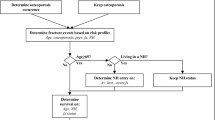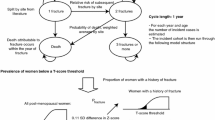Abstract
The aim of our study was to develop a modeling framework suitable to quantify the incidence, absolute number and economic impact of osteoporosis-attributable hip, vertebral and distal forearm fractures, with a particular focus on change over time, and with application to the situation in Switzerland from 2000 to 2020. A Markov process model was developed and analyzed by Monte Carlo simulation. A demographic scenario provided by the Swiss Federal Statistical Office and various Swiss and international data sources were used as model inputs. Demographic and epidemiologic input parameters were reproduced correctly, confirming the internal validity of the model. The proportion of the Swiss population aged 50 years or over will rise from 33.3% in 2000 to 41.3% in 2020. At the total population level, osteoporosis-attributable incidence will rise from 1.16 to 1.54 per 1,000 person-years in the case of hip fracture, from 3.28 to 4.18 per 1,000 person-years in the case of radiographic vertebral fracture, and from 0.59 to 0.70 per 1,000 person-years in the case of distal forearm fracture. Osteoporosis-attributable hip fracture numbers will rise from 8,375 to 11,353, vertebral fracture numbers will rise from 23,584 to 30,883, and distal forearm fracture numbers will rise from 4,209 to 5,186. Population-level osteoporosis-related direct medical inpatient costs per year will rise from 713.4 million Swiss francs (CHF) to CHF946.2 million. These figures correspond to 1.6% and 2.2% of Swiss health care expenditures in 2000. The modeling framework described can be applied to a wide variety of settings. It can be used to assess the impact of new prevention, diagnostic and treatment strategies. In Switzerland incidences of osteoporotic hip, vertebral and distal forearm fracture will rise by 33%, 27%, and 19%, respectively, between 2000 and 2020, if current prevention and treatment patterns are maintained. Corresponding absolute fracture numbers will rise by 36%, 31%, and 23%. Related direct medical inpatient costs are predicted to increase by 33%; however, this estimate is subject to uncertainty due to limited availability of input data.


Similar content being viewed by others
References
Cummings SR, Melton LJ (2002) Epidemiology and outcomes of osteoporotic fractures. Lancet 359:1761–1767
Seeley DG, Browner WS, Nevitt MC, Genant HK, Scott JC, Cummings SR (1991) Which fractures are associated with low appendicular bone mass in elderly women? The Study of Osteoporotic Fractures Research Group. Ann Intern Med 115:837–842
Dennison E, Cooper C (2000) Epidemiology of osteoporotic fractures. Horm Res 54 [Suppl 1]:58–63
Cooper C (1997) The crippling consequences of fractures and their impact on quality of life. Am J Med 103:12S–17S
Cooper C, Campion G, Melton LJ 3rd (1992) Hip fractures in the elderly: a world-wide projection. Osteoporos Int 2:285–289
Gullberg B, Johnell O, Kanis JA (1997) World-wide projections for hip fracture. Osteoporos Int 7:407–413
Sanders KM, Nicholson GC, Ugoni AM, Pasco JA, Seeman E, Kotowicz MA (1999) Health burden of hip and other fractures in Australia beyond 2000. Projections based on the Geelong Osteoporosis Study. Med J Aust 170:467–470
Chrischilles EA, Butler CD, Davis CS, Wallace RB (1991) A model of lifetime osteoporosis impact. Arch Intern Med 151:2026–2032
Chrischilles E, Shireman T, Wallace R (1994) Costs and health effects of osteoporotic fractures. Bone 15:377–386
Doherty DA, Sanders KM, Kotowicz MA, Prince RL (2001) Lifetime and five-year age-specific risks of first and subsequent osteoporotic fractures in postmenopausal women. Osteoporos Int 12:16–23
Braithwaite RS, Col NF, Wong JB (2003) Estimating hip fracture morbidity, mortality and costs. J Am Geriatr Soc 51:364–370
Burge RT, King AB, Balda E, Worley D (2003) Methodology for estimating current and future burden of osteoporosis in state populations: application to Florida in 2000 through 2025. Value Health 6:574–583
Lippuner K, von Overbeck J, Perrelet R, Bosshard H, Jaeger P (1997) Incidence and direct medical costs of hospitalizations due to osteoporotic fractures in Switzerland. Osteoporos Int 7:414–425
Lippuner K, Jaeger P (1998) Direkte Spitalkosten durch osteoporosebedingte Hüftfrakturen in der Schweiz heute und im Jahr 2020: Ein sozioökonomischer Alptraum. Schweiz Ärztezeitung 79:690–697
Meine J, Regazzoni P, Konig W (1993) Fractures of the proximal femur: rehabilitation and socioeconomic repercussions. Z Unfallchir Versicherungsmed 86:66–80
Sendi P, Palmer AJ (2000) Modeling the socioeconomic impact of osteoporosis-related hip fractures in Switzerland. Osteoporos Int 11:92–94
Briggs A, Sculpher M (1998) An introduction to Markov modelling for economic evaluation. Pharmacoeconomics 13:397–409
Miller DK, Homan SM (1994) Determining transition probabilities: confusion and suggestions. Med Decis Making 14:52–58
Bundesamt für Statistik (2002) Szenarien zur Bevölkerungsentwicklung der Schweiz 2000–2060. Vollständiger Szenariensatz. Neuchâtel: Bundesamt für Statistik
Kanis JA, Johnell O, De Laet C, Jonsson B, Oden A, Ogelsby AK (2002) International variations in hip fracture probabilities: implications for risk assessment. J Bone Miner Res 17:1237–1244
The European Prospective Osteoporosis Study (EPOS) Group (2002) Incidence of vertebral fracture in Europe: results from the European Prospective Osteoporosis Study (EPOS). J Bone Miner Res 17:716–724
de Laet CE, Pols HA (2000) Fractures in the elderly: epidemiology and demography. Baillieres Best Pract Res Clin Endocrinol Metab 14:171–179
Kanis JA, Johnell O, Oden A, Sembo I, Redlund-Johnell I, Dawson A, et al (2000) Long-term risk of osteoporotic fracture in Malmö. Osteoporos Int 11:669–674
Black DM, Cooper C (2000) Epidemiology of fractures and assessment of fracture risk. Clin Lab Med 20:439–453
Ismail AA, Pye SR, Cockerill WC, Lunt M, Silman AJ, Reeve J, et al (2002) Incidence of limb fracture across Europe: results from the European Prospective Osteoporosis Study (EPOS). Osteoporos Int 13:565–571
Melton LJ 3rd, Thamer M, Ray NF, Chan JK, Chesnut CH 3rd, Einhorn TA, et al (1997) Fractures attributable to osteoporosis: report from the National Osteoporosis Foundation. J Bone Miner Res 12:16–23
Trombetti A, Herrmann F, Hoffmeyer P, Schurch MA, Bonjour JP, Rizzoli R (2002) Survival and potential years of life lost after hip fracture in men and age-matched women. Osteoporos Int 13:731–737
Ismail AA, O’Neill TW, Cooper C, Finn JD, Bhalla AK, Cannata JB, et al (1998) Mortality associated with vertebral deformity in men and women: results from the European Prospective Osteoporosis Study (EPOS). Osteoporos Int 8:291–297
Cooper C, Atkinson EJ, Jacobsen SJ, O’Fallon WM, Melton LJ 3rd (1993) Population-based study of survival after osteoporotic fractures. Am J Epidemiol 137:1001–1005
Ensrud KE, Thompson DE, Cauley JA, Nevitt MC, Kado DM, Hochberg MC, et al (2000) Prevalent vertebral deformities predict mortality and hospitalization in older women with low bone mass. Fracture Intervention Trial Research Group. J Am Geriatr Soc 48:241–249
Center JR, Nguyen TV, Schneider D, Sambrook PN, Eisman JA (1999) Mortality after all major types of osteoporotic fracture in men and women: an observational study. Lancet 353:878–882
Melton LJ 3rd (2000) Excess mortality following vertebral fracture. J Am Geriatr Soc 48:338–339
Cooper C, Atkinson EJ, Kotowicz M, O’Fallon WM, Melton LJ 3rd (1992) Secular trends in the incidence of postmenopausal vertebral fractures. Calcif Tissue Int 51:100–104
Melton LJ 3rd, Lane AW, Cooper C, Eastell R, O’Fallon WM, Riggs BL (1993) Prevalence and incidence of vertebral deformities. Osteoporos Int 3:113–119
Bonjour JP, Burckhardt P, Dambacher M, Kraenzlin ME, Wimpfheimer C (1997) [Epidemiology of osteoporosis]. Schweiz Med Wochenschr 127:659–667
Pientka L (1996) Die ökonomische Bedeutung der Osteoporose in Deutschland. Deutsches Ärztemagazin 8:44–52
Schürch MA, Rizzoli R, Mermillod B, Vasey H, Michel JP, Bonjour JP (1996) A prospective study on socioeconomic aspects of fracture of the proximal femur. J Bone Miner Res 11:1935–1942
Dolan P, Torgerson DJ (1998) The cost of treating osteoporotic fractures in the United Kingdom female population. Osteoporos Int 8:611–617
Haentjens P, Autier P, Barette M, Boonen S (2001) The economic cost of hip fractures among elderly women. A one-year, prospective, observational cohort study with matched-pair analysis. Belgian Hip Fracture Study Group. J Bone Joint Surg Am 83-A:493–500
Gabriel SE, Tosteson AN, Leibson CL, Crowson CS, Pond GR, Hammond CS, et al (2002) Direct medical costs attributable to osteoporotic fractures. Osteoporos Int 13:323–330
Wiktorowicz ME, Goeree R, Papaioannou A, Adachi JD, Papadimitropoulos E (2001) Economic implications of hip fracture: health service use, institutional care and cost in Canada. Osteoporos Int 12:271–278
Szucs TD, Häuselmann HJ (2000) Die Wirtschaftlichkeit von Alendronat in der Behandlung der postmenopausalen Osteoporose. Gesundh Ökon Qual Manag 5:99–106
Johnell O, Gullberg B, Allander E, Kanis JA (1992) The apparent incidence of hip fracture in Europe: a study of national register sources. MEDOS Study Group. Osteoporos Int 2:298–302
Wasnich RD (1997) Epidemiology of osteoporosis in the United States of America. Osteoporos Int 7 [Suppl 3]:S68–72
Phillips S, Ray NF, Jacobs J, Wright WE (1988) The direct medical costs of osteoporosis for American women aged 45 and older, 1986. Bone 9:271–279
Diamond TH, Thornley SW, Sekel R, Smerdely P (1997) Hip fracture in elderly men: prognostic factors and outcomes. Med J Aust 167:412–415
Oskam J, Kingma J, Klasen HJ (1998) Fracture of the distal forearm: epidemiological developments in the period 1971–1995. Injury 29:353–355
Acknowledgments
This study was supported by an unrestricted, educational grant from Merck Sharp & Dohme-Chibret AG, Glattbrugg, Switzerland.
Author information
Authors and Affiliations
Corresponding author
Rights and permissions
About this article
Cite this article
Schwenkglenks, M., Lippuner, K., Häuselmann, H.J. et al. A model of osteoporosis impact in Switzerland 2000–2020. Osteoporos Int 16, 659–671 (2005). https://doi.org/10.1007/s00198-004-1743-x
Received:
Accepted:
Published:
Issue Date:
DOI: https://doi.org/10.1007/s00198-004-1743-x




